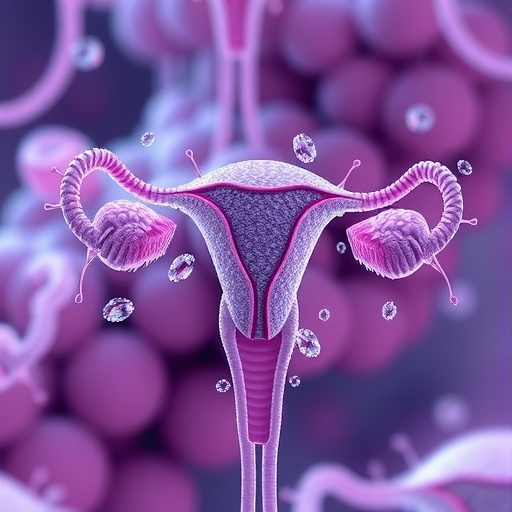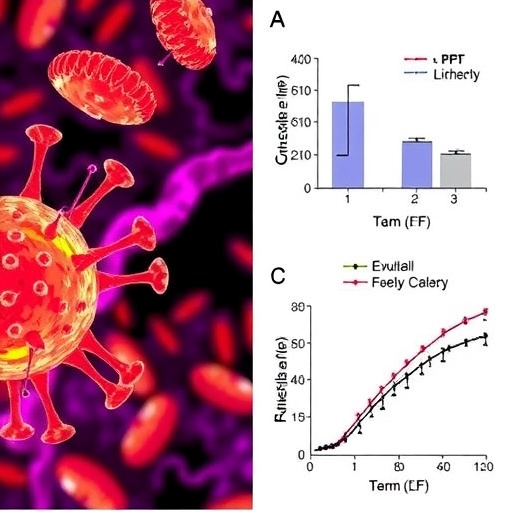Recent developments in regenerative medicine have illuminated an exciting potential for exosome therapy, particularly in the realm of reproductive health. A groundbreaking study led by Cui et al. has put forth an innovative approach aimed at addressing premature ovarian failure, particularly in contexts induced by chemotherapeutic agents such as cyclophosphamide. This research highlights the capacity of exosomes derived from mesenchymal stem cells (MSCs) to restore ovarian function, shedding light on a previously obscured pathway that relies on the modulation of pyroptosis, a form of programmed cell death.
Exosomes, nano-sized extracellular vesicles secreted by various cell types, have emerged as powerful mediators of intercellular communication. They carry a cargo rich in proteins, lipids, and nucleic acids, and facilitate the transfer of these bioactive molecules between cells. In the context of reproductive health, exosomes represent an attractive therapeutic tool due to their ability to repair tissue damage and modulate inflammatory responses.
The study introduces a novel mechanism through which MSC-derived exosomes exert protective effects on ovarian function, particularly under conditions of injury or stress-induced by cyclophosphamide. Cyclophosphamide, a commonly used chemotherapeutic agent, has been known to induce cellular damage, leading to adverse outcomes in ovarian health, including premature ovarian failure. The authors of this study delineate how MSC-derived exosomes can intervene in this destructive sequence of events.
The researchers discovered that these exosomes possess the capacity to suppress NLRP3-mediated pyroptosis, a highly inflammatory form of cell death driven by the NLRP3 inflammasome. Pyroptosis is characterized by cell swelling, lytic cell death, and the subsequent release of inflammatory cytokines, contributing to local tissue damage and systemic inflammation. This is particularly relevant in the context of ovarian function, where inflammatory processes can significantly impair fertility.
Through a series of in vitro and in vivo experiments, the study elucidates the molecular pathways by which MSC-derived exosomes confer their protective effects. The exosomes were shown to carry specific microRNAs and proteins that can dampen the activation of the NLRP3 inflammasome. By inhibiting this pathway, the exosomes facilitate a shift from a pro-inflammatory to an anti-inflammatory environment, thus preserving the health and functionality of ovarian follicles.
In a key aspect of the study, the researchers utilized a model of cyclophosphamide-induced premature ovarian failure in experimental organisms. Administering MSC-derived exosomes in this model demonstrated a marked restoration of ovarian function, as evidenced by improved estrous cyclicity and enhanced follicle development. The results are striking and suggest that these exosomal therapies could represent a pivotal shift in managing ovarian dysfunction related to chemotherapy.
Furthermore, the safety profile of MSC-derived exosome therapy has fortified its attractiveness as a clinical intervention. As naturally occurring nanovesicles, exosomes exhibit low immunogenicity, reducing the risks associated with traditional cellular therapies. This natural origin allows for their potential use in a wide range of conditions without the complications of graft-versus-host disease, which is often a concern in stem cell treatments.
The findings from Cui et al.’s study are particularly crucial given the increasing number of cancer survivors who face reproductive health challenges post-therapy. With advancements in cancer treatment, the survival rates have risen significantly; however, the quality of life post-treatment often suffers due to infertility. Addressing this gap through the use of MSC-derived exosomes could vastly improve the overall well-being of these patients and provide a new lease on life regarding their reproductive options.
An intriguing aspect of the study is the identification of specific cargo components within the exosomes that mediate their protective effects. This raises the possibility of tailoring exosomal therapies to enhance their efficacy further. By understanding which specific proteins or microRNAs are most effective in reducing pyroptosis, researchers could develop more targeted treatments that maximize ovarian restoration.
In parallel with the therapeutic implications of this research, the study also challenges existing paradigms in the field of reproductive immunology. The interaction between the immune system and ovarian function is complex, with inflammation playing a dual role. Understanding the balance between protective and detrimental inflammation is critical, and MSC-derived exosomes might hold the key to navigating this complex landscape.
As the research community continues to explore the potential of exosomes, the implications extend beyond reproductive health. The mechanisms of MSC-derived exosome action could offer insights into various inflammatory diseases, suggesting a broader applicability of this innovative approach. Future studies are likely to explore the role of exosomes in other organ systems, potentially leading to cross-disciplinary advancements in treatment strategies.
The involvement of exosomal therapies in reproductive medicine is still in its infancy, but the promising results presented by Cui et al. lay a robust foundation for future research and clinical trials. The prospect of utilizing exosomes not only for ovarian repair but for other areas of reproductive health invites a new era of exploration and therapeutic design.
Looking ahead, the translation of these findings into clinical practice will require rigorous testing to establish safety, efficacy, and optimal delivery methods for exosome therapies. However, the prospects are bright, indicating a transformative potential in how we approach treatment for conditions like premature ovarian failure.
In conclusion, the work of Cui and colleagues marks a pivotal moment in the exploration of exosomal therapies for ovarian health. By elucidating the role of MSC-derived exosomes in inhibiting NLRP3-mediated pyroptosis, this research opens new avenues for understanding and treating ovarian dysfunction, presenting a hopeful future for patients affected by the consequences of chemotherapy.
Subject of Research: Exosomes derived from mesenchymal stem cells and their role in ovarian function repair.
Article Title: Exosomes derived from mesenchymal stem cells repair ovarian function by suppressing NLRP3-mediated pyroptosis in cyclophosphamide-induced premature ovarian failure.
Article References:
Cui, X., Li, H., Huang, X. et al. Exosomes derived from mesenchymal stem cells repair ovarian function by suppressing NLRP3-mediated pyroptosis in cyclophosphamide-induced premature ovarian failure.
J Ovarian Res 18, 216 (2025). https://doi.org/10.1186/s13048-025-01785-1
Image Credits: AI Generated
DOI: 10.1186/s13048-025-01785-1
Keywords: Exosomes, Mesenchymal Stem Cells, Ovarian Function, NLRP3, Pyroptosis, Cyclophosphamide, Premature Ovarian Failure.
Tags: bioactive molecules in reproductive therapycyclophosphamide effects on ovariesexosome therapy for ovarian functionextracellular vesicles in ovarian repairinflammation modulation in ovarian injuryintercellular communication in ovarian functionmesenchymal stem cell exosomesovarian health restoration strategiespremature ovarian failure treatmentpyroptosis modulation in reproductive healthregenerative medicine in reproductive healththerapeutic applications of exosomes





